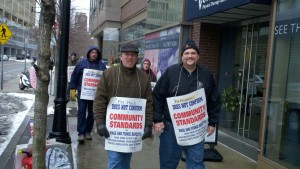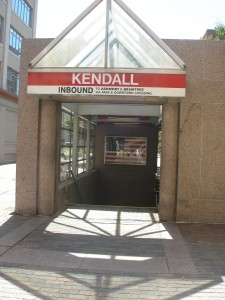You don’t need to be a geek to get into some of the newest technology for keeping track of your health. I was blown away when I heard about pill bottle caps that will tell you (or your doctor or your caretakers) if you’ve forgotten to take your meds…a kazoo that measures the chemistry of the air from your lungs…and a telephone that can assess whether you’re depressed–from the tones of your voice.
These gizmos are the brainchildren of David Rose, an entrepreneur who is now the CEO of Vitality, Inc., in Cambridge. Rose has also invented bathroom scales that can show whether you’ve lost or gained weight, an umbrella that can sense whether it’s going to rain, and objects that assess air quality.
Rose was one of four panelists who spoke last week at a program sponsored by the Medical Development Group about some astounding new health gadgets, most of which are actually on the market. (MDG is a Boston area organization for individuals involved in the medical device and technology industries).
Rose focused on the above-mentioned pill bottle “Glo-Caps”, which “sense” when a patient takes a medication, and, via a wireless Internet connection, show health care professionals, patients or caregivers whether reminders are needed.
The caps light up, play a melody, and even ring a home phone to remind patients to take their pills. The caps can send weekly emails to remote caregivers, create accountability with doctors through an adherence report, and automatically refill prescriptions.
Glo-Caps are not currently available for purchase by individuals, but they are being used by patients enrolled in programs sponsored by certain health insurers and pharmacies.
Panelist Ben Rubin, Co-Founder and Chief Technology officer of Zeo, in Newton, MA, described Zeo’s novel headset and device that monitor an individual’s REM sleep and factors influencing sleep patterns. Knowing how well you sleep is important because sleep is closely tied to health conditions like obesity, depression, diabetes and the like, Rubin said. “If you measure it, you can manage it.”
Zeo’s sleep devices, which cost $250, connect to an Internet site. For an additional $100, Zeo provides email advice coaching to help individuals improve their “sleep hygiene.”
There’s also a Smart Phone application designed to promote better sleep: using the Ap, you put your phone under your pillow to measure your movement (and restlessness) during sleep.
Panelists also described glucose monitors that send data to doctors via patients’ Smart Phones and Nike running shoes that measure your steps. At one point, Rose pulled out a keychain that tells him whether he’s met his daily walking goals and whether he’s on track (ha ha) to meet his monthly goals.
Also mentioned were Internet tools such as a Google Ap to measure flu trends; Healthmedia, through which Johnson & Johnson provides digital coaching for managing stress and chronic disease, Philips Direct, which provides live coaching over email, and various “calorie and other body monitors through which individuals can receive online coaching through gyms.
All of these devices fall under a category moderator David Barash, MD, CEO of Concord [MA] Health Strategies calls “local health monitoring” –meaning that the devices can be used by patients or consumers almost anywhere–rather than just at home or in a hospital, doctor’s office or lab.
According to a recent review by my client, Scientia Advisors, “remote health monitoring” devices are the fastest growing category in a booming home health care market.
The devices are growing in popularity in sync with an aging population, increasing chronic disease, and new Internet technologies, Barash said.
Panelist Frank McGillin, Vice President of Global Marketing for Philips Healthcare, which markets a variety of home monitoring devices, said remote monitoring will become increasing important in light of growing health care costs.
Gillin cited government statistics showing that health care current accounts for 17.6 percent of the gross domestic product in the US, and that by 2050, half of the population in the developed world will be chronically ill—making traditional medical care fiscally overwhelming.
Devorah Klein, PhD, a principal at Continuum, in Newton, MA, who designs devices and evaluates patient adherence to therapy regimes for diabetes, asthma, arthritis, multiple sclerosis and erectile dysfunction, emphasized that simple designs are key because “many patients are not all that interested” in learning to use devices.
And Barash pointed out that while many consumers may be intrigued by these gizmos, doctors have been slow to embrace them.
For one thing, with a dearth of clinical trials to assess devices’ effectiveness, insurers are reluctant to reimburse doctors for evaluating the data thus compiled.
For another, it’s not clear how doctors can manage or assess potentially large amounts of additional data, or how data collected for individual conditions can be assessed in relation to data collected elsewhere for other, possibly related, conditions.
–Anita M. Harris
New Cambridge Observer is published by the Harris Communications Group, a writing and public relations firm in Cambridge, MA. All rights reserved.
 Local AFL-CIO Insulators, Tin Kinockers and Pipefitters from Cambridge Local use a large inflatable rat to make clear how they feel about the use of non-union, non-Cambridge workers by PH Mechanical for work currently underway at 302 Third Street in Kendall Square. “They don’t conform to community standards; they are unlicensed, and they have no apprentice program,” said one union member who declined to give his name. He said he expects that Cambridge City Council will be discussing the issue at its next meeting, possibly this evening.
Local AFL-CIO Insulators, Tin Kinockers and Pipefitters from Cambridge Local use a large inflatable rat to make clear how they feel about the use of non-union, non-Cambridge workers by PH Mechanical for work currently underway at 302 Third Street in Kendall Square. “They don’t conform to community standards; they are unlicensed, and they have no apprentice program,” said one union member who declined to give his name. He said he expects that Cambridge City Council will be discussing the issue at its next meeting, possibly this evening. Photos C. Anita M. HarrisInsulators, Tin Knocker, & Pipefitters Local AFL-CIO unions protest use of non-union workers at 302 3rd St.
Photos C. Anita M. HarrisInsulators, Tin Knocker, & Pipefitters Local AFL-CIO unions protest use of non-union workers at 302 3rd St.


